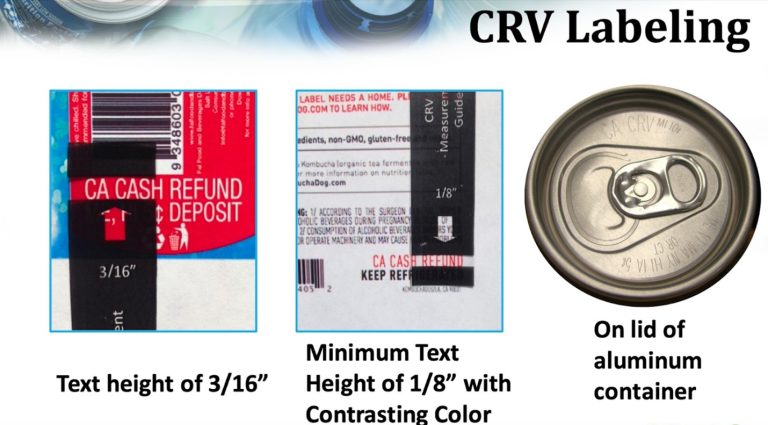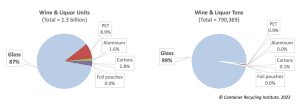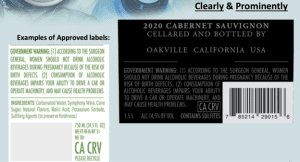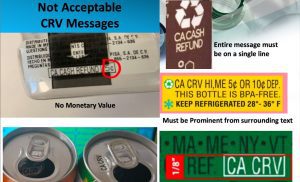
Wineries have until Jan. 1, 2024 to sign up with CalRecycle to start reporting each month the number of wine bottles, cans and bag-in-box items they produce. It’s all part of the new bottle bill, SB 1013, passed in 2022.
The new law going into effect has two important deadlines for producers.
Part 1, due Jan. 1, 2024, is reporting and paying a small fee per container.
Part 2, due July 1, 2025, is labeling all containers with recycling redemption language, following specific CalRecycle mandated guidelines.

Part 1: Reporting and Paying
Before this new law went into effect, consumers could turn in bottles and cans for non-alcoholic beverages for redemption and receive 5 or 10 cents back per item. The issue is that most did not visit a specific recycling center to get those nickels and dimes, but rather deposited their empties in municipal waste pickup programs.
The new law expands returnables to wine and spirits containers. It also requires retailers to do a better job of accepting returnables.
Then two months after the start of the Jan. 1, 2024 reporting deadline, producers will be required to pay fees based on the numbers in those reports.
The idea is to close the loop between producers and the potential waste they create. Redemption increases recycling rates, experts say. It also creates better-quality glass returns, researchers report, and that makes this recycled glass more attractive for reuse by glass manufacturers.

According to CalRecycle, the bill will bring 4,200 California wineries into the fold and is expected to add 1.1 billion wine and spirits containers to recycling. That’s an overall increase of 4%, a department spokesperson said.
The CalRecycle registration page has details. The agency also has representatives available to assist in filling out registration forms.
Beginning in March 2024, producers will begin paying “processing fees.” The price is not fixed but is very low. Currently, the fee is $0.00452 per bottle, $0.00005 per plastic container and $0.00762 for a box or equivalent.
Tasting rooms in California do not need to report or pay processing fees, but any out-of-state wineries selling to Californians must report monthly and pay processing fees.

Part Two: Labeling Changes
After completing the first phase of reporting and paying fees, the second big deadline takes place 18 months later on July 1, 2025. By then, wine and spirits containers sold in California must be labeled with the California Redemption Value (CRV) code.
Consumers will then begin paying CRV deposits of five cents for containers under 24 ounces, 10 cents for containers of 24 ounces or more and a flat rate of 25 cents for bag-in-box packaging (regardless of size).
CalRecycle offers wineries five options for the message to display on the container: California Redemption Value, CA Redemption Value, California Cash Refund, CA Cash Refund or CA CRV.
There’s more information available in the CalRecycle webinar, posted on its YouTube channel, and website instructions provide requirements and example how-to’s.
The labeling must be “clearly, prominently and indelibly marked,” according to the website.
For glass and plastic, the message needs to be on the container body label or secondary label. The text height should be 3/16 inches, or it can be 1/8 inches if it is in a contrasting color to the background and nearby text.

For aluminum cans, the message must be on the top lid. If the top is more than two inches in diameter, the message must be 3/16 inches in height. If the top is 2 inches or less in diameter, the message must be 1/8 inches in height.
The agency is still working on details for box, bladder and pouch product labeling.
No monetary value appears in the messaging as that is subject to change in the future, CalRecycle said.
The CalRecycle website has do’s and don’ts examples posted on its website.
The End Goal: More Efficient Glass Reuse
According to Scott Defife of the Glass Packaging Institute, “California bottles have 40% recycled content. Oregon bottles have 70% recycled content. Washington bottles have 50% recycled content.”
CalRecycle hopes the redemption program will increase the recycling rate to 80% and increase glass reuse by glass manufacturers.
Industry researchers from the Container Recycling Institute say glass returned outside the consumer redemption system (where it is mixed in with other recycling items) is dirtier and costs $20 a ton to recycle. That’s in contrast to cleaner glass handled through redemption centers where it’s worth $20 a ton and is attractive to glass manufacturers.
Resources
CalRecycle online webinar: youtube.com/watch?v=x50d5FYvQdA
CalRecycle’s Beverage Distributors and Manufacturers: calrecycle.ca.gov/BevContainer/BevDistMan/
Bottle Bill resource page: wineinstitute.org/our-industry/bottle-bill/







